The 11th time is the charm. The Toronto Maple Leafs finally finished off a playoff series when given the chance to do so, defeating the Tampa Bay Lightning 2-1 in overtime on Saturday night to clinch the series 4-2.
The Leafs didn’t just exorcise their own demons; they did something no team in the East since Columbus in 2019 could do by eliminating the Lightning from the playoffs.
Indeed, this was a feat. Beating Montreal in 2021, or Columbus in 2020, wouldn’t have been seen as all that much of an accomplishment in the grand scheme, beyond finally winning a round. But beating the Lightning? Yeah, that’s an achievement whenever you do it.
This year’s Bolts team was a reduced version of previous ones, but they were still a damn good hockey team, and they fought the Leafs tooth and nail. This is a team that has only been eliminated in the playoffs before the third round once previously since 2015.
So how did the Leafs do it? How did they slay the Lightning’s dragon and get the monkey off their back? Let’s break it down.
Goaltending
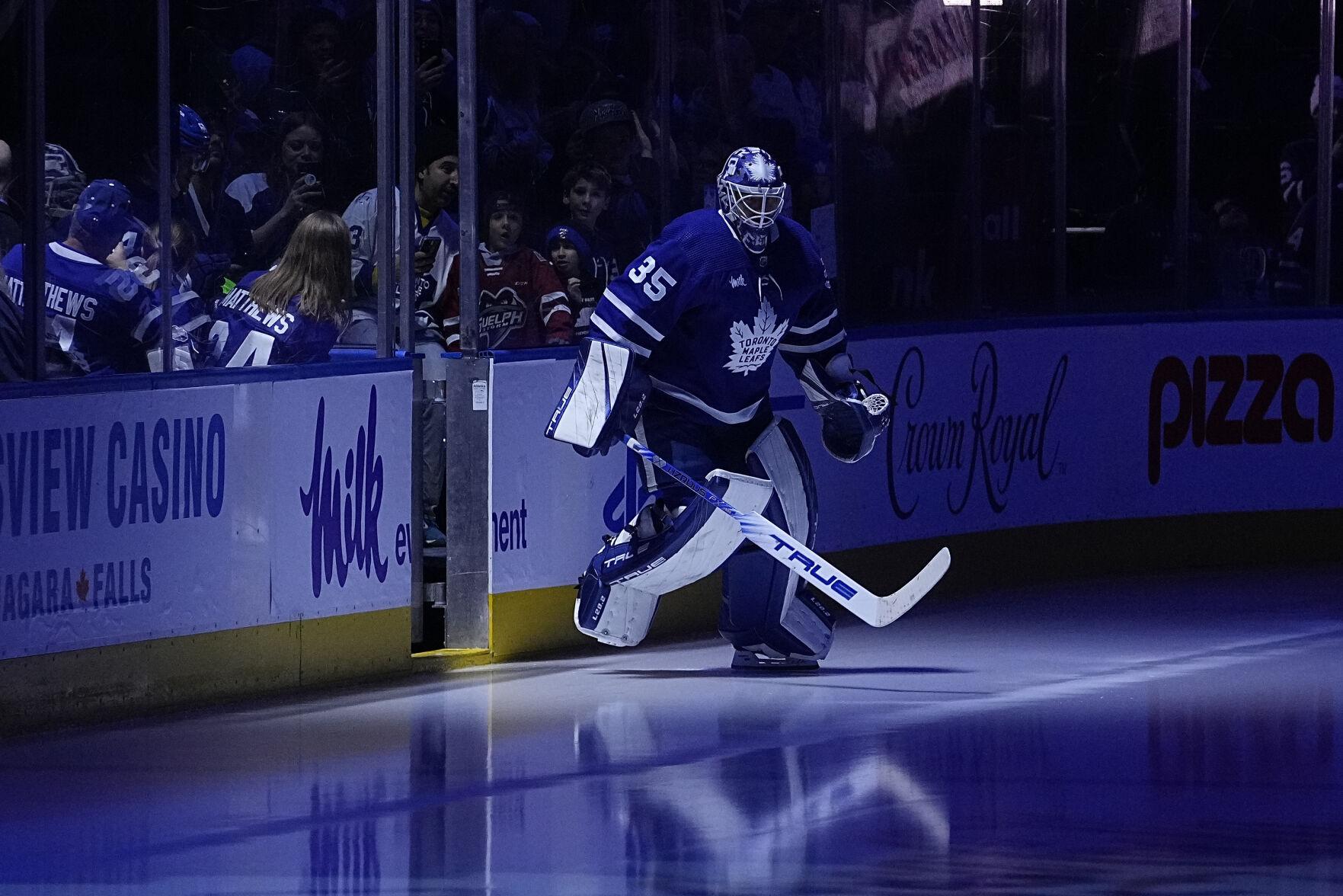
Let’s start with what was the biggest difference in the series: goaltending, both in what decided the series and also what allowed the Maple Leafs to perform differently than in years past.
Coming into this series, you’d probably have said that goaltending was the biggest difference between the Leafs and Lightning, but your assumption would have been that it was an advantage for Tampa.
My general belief was that the Leafs didn’t need better goaltending than the Bolts; they just needed Ilya Samsonov to keep the gap between himself and Andrei Vasilevskiy small enough.
Turns out, the Leafs did need Samsonov to be better. Tampa played stronger than many expected, Jon Cooper deployed a variety of tactical adjustments that flustered the Leafs for long stretches, and they needed their goalie to step up. Samsonov delivered.
In the plainest terms, Samsonov vs. Vasilevskiy was the difference. Evolving Hockey credited Samsonov for +0.02 goals saved above expected, while Vasilevskiy was down at -3.69. The margin for the series in goals (excluding empty netters) was Leafs +3. If you want to include Joe Woll‘s one period of action as part of Toronto’s total, the team difference in goaltending via GSAx was almost exactly three, matching the series margin. It all came down to the fellas in net.
Samsonov’s full series numbers look pretty neutral — .900 save percentage and the aforementioned +0.02 clip in the advanced metrics – but he was excellent after Game 1: 4-1, .919 SV%, +2.25 GSAx following the garbage opener. He was bumpy in Game 5 and still seemed to be fighting it at times throughout the series, but his best moments of the series were the biggest.
Samsonov stole the team Game 3 in Tampa during the third period and OT, and he was just as good throughout the entirety of Game 6. That was the biggest difference for Toronto compared to past elimination game failures: they got the goaltending to get it done this time.
Samsonov’s Game 6 showing was indeed a “we’re not losing tonight” game. The one goal he allowed was off a rebound when two Lightning were left alone in front. Nothing he could do about that one. Everything else, he was money on.
Samsonov stopped a Mikey Eyssimont 2v1 rush chance in overtime as well as several saves against the Brayden Point line and one notable shot by Nick Paul in the third period. Samsonov stopped 31 of 32 shots on the evening for a .969 SV%. It was by far the best goaltending performance the Leafs have gotten in a possible clinching during this core’s existence, perhaps only rivaled by Jack Campbell’s Game 6 against Montreal in 2021.
Here are the SV% clips of Leafs goalies in the previous clinching games: .829, .925, .900, .905, .867, .903, .909, .886, .920, .919. Far and away the best. No giving up the first goal, no backbreaking howler from an obscure angle, and no goals allowed immediately after the Leafs scored.
In total, Samsonov wasn’t incredible in this series, but he was money when it mattered. Also of importance: He was better than the goalie in the other net, Andrei Vasilevskiy.
The Lightning’s vaunted starter was largely poor in the series, giving up 19 goals in the first four games before allowing only two in games 5 and 6. Vasilevskiy and Samsonov both weren’t great through four, but Samsonov was better. Vasilevskiy and Samsonov both were much better in games 5 and 6, but Samsonov was again better. Vasilevskiy struggled to pick up point shots through traffic often in this series, Samsonov had no such consistent weakness.
Above all else, Samsonov was perfect in OT, while Vasilevskiy allowed three game-winners in the extra session. Goaltending was the final decider.
Timely Goals
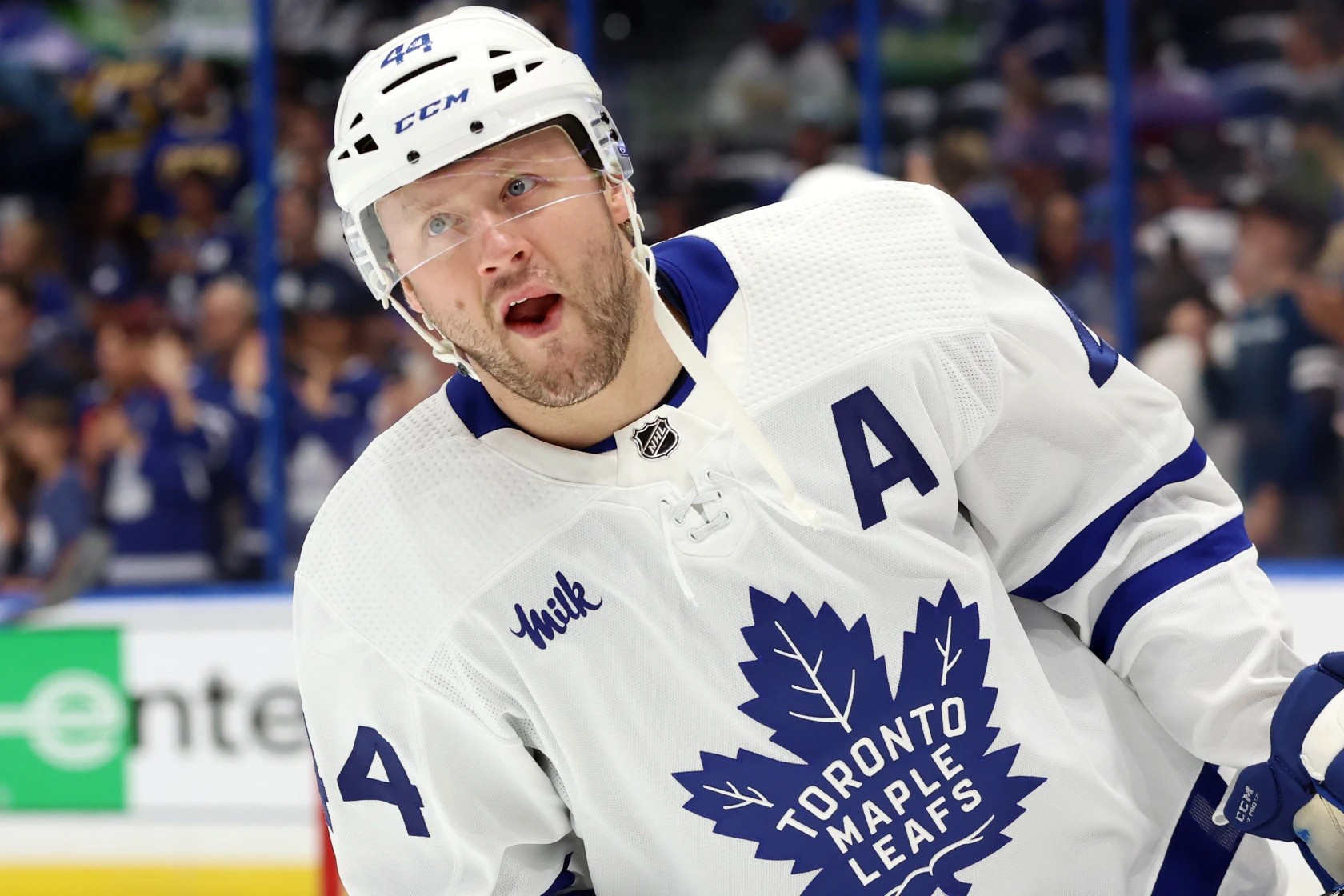
Not a ton of deep analysis is needed here, but the Leafs got the biggest, most timely goals in this series. Tampa Bay scored a couple of big ones in the middle of games to swing momentum — particularly Brayden Point’s PP tally in Game 1 and Anthony Cirelli’s goal less than 30 seconds after Toronto opened the scoring in Game 5 — but the Leafs going 3-0 in OT in this series speaks for itself in terms of the squad’s ability to get the big goal.
When you toss in the Ryan O’Reilly equalizer with one minute left in Game 3 to force OT, the four highest-importance goals in this series were all scored by the Toronto Maple Leafs. That was a pivotal difference in this series and also another departure from years past.
It’s been a common storyline in this era of Leafs teams that Toronto needs to play near-perfect games, or at the very least be firmly the better team, to win a playoff game. Meanwhile, the opposition wins a number of games where the Leafs felt like the team who let ’em off the hook, making a big mistake, or giving up an unforgivable bad goal at a crucial time.
Think about the series last year. In Game 6, the Leafs were creating beautiful goals for themselves while the Lightning scored a shorthanded goal off a bad pass by Ilya Mikheyev, a mini-break after Alex Kerfoot made a drop-pass to no one, and then a 5v3 goal after the Leafs took back to back penalties while leading in the third period protecting a one-goal lead. That’s been the story for the Leafs too often in the playoffs — finding ways to lose games.
The script was reversed in this series. You can make a very compelling case that the Lightning were the better team in both Games 3 and 6. They controlled long stretches of Game 4 before the comeback started. But the Leafs hung around, using good goaltending and shot-blocking to survive long cycle shifts by the Bolts, and then they got the big goal that leveled the playing field or put themselves ahead.
The big mistake — the kind that haunted past Leafs teams — wasn’t seen much. Turnovers did happen, but they survived most of them. Ilya Samsonov did give up a classic terrible goal in Game 5 that made many Leafs fans say, “here we go again,” but then Samsonov bounced back to incredible in Game 6.
In some ways, Samsonov’s resiliency was emblematic of the whole team. He hung in there and battled before coming up gold in the biggest moments. Where Steven Stamkos couldn’t beat Samsonov in the overtime of Game 3 even at point-blank range, the Leafs found ways to slip pucks by Vasilevskiy, be it through a floating wrist shot in traffic (Morgan Rielly in Game 3), a deflection in front (Alex Kerfoot in Game 4), or tossing a puck on net and getting a lucky bounce off the opposition’s skate (John Tavares in Game 6).
After going 2-1 in OT back in 2017 to begin this era, the Leafs lost six of the next seven OT games they played in the postseason entering this series. Three times they were in OT in possible clinching games, where one goal would’ve broken the curse. They couldn’t get that goal then, but this time they did.
Core Production
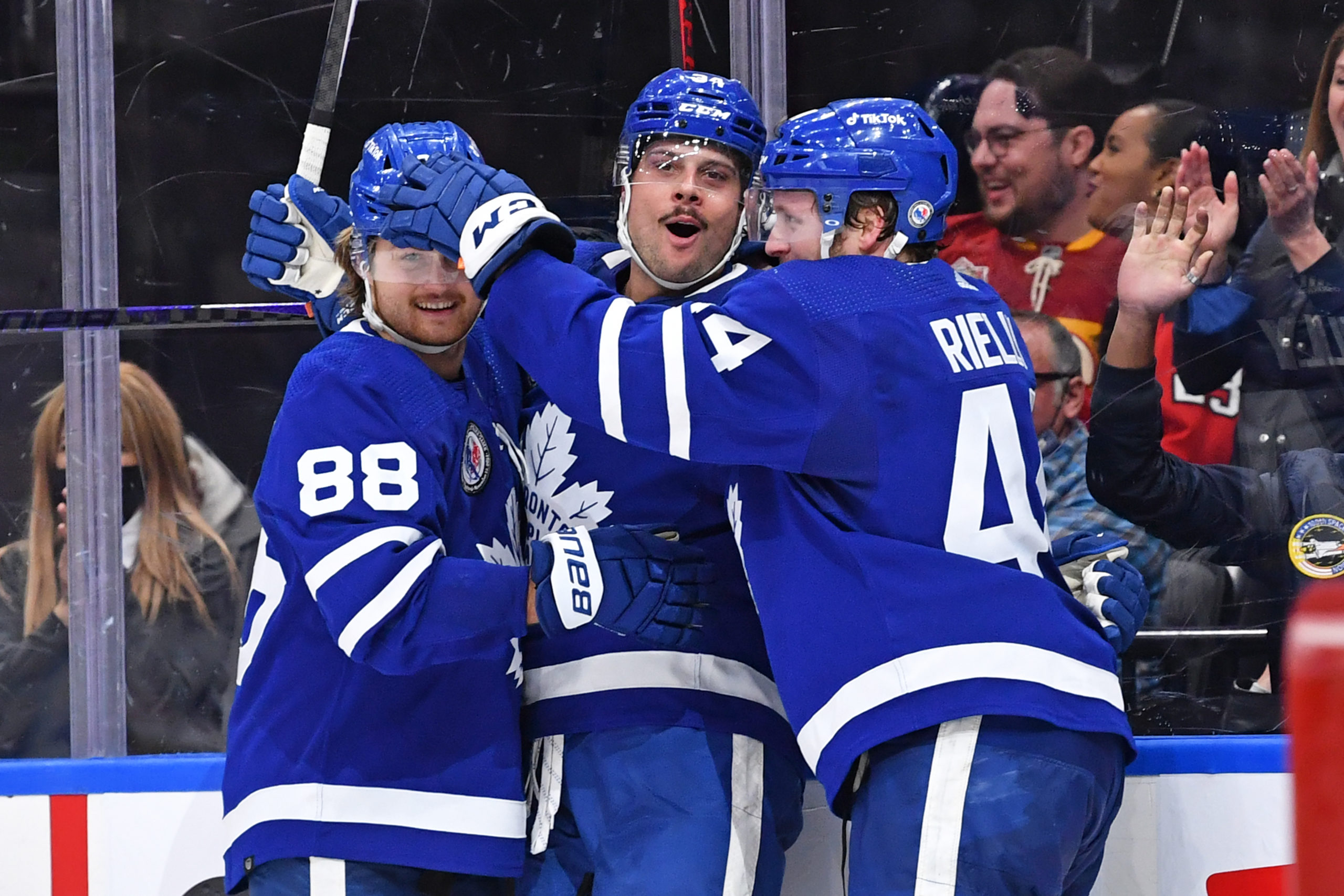
There’s a great hockey cliche that in the playoffs you need your best players to be your best players. There were times in this era of the Leafs that this statement had not been true, but it was this series. And crucially, it was for the Leafs, while it wasn’t for Tampa.
Let’s start on the Toronto side, where I would argue the two top skaters for the Maple Leafs were Auston Matthews and Morgan Rielly. They combine for over a $19 M cap hit, the kind of money you expect to produce when the season is on the line. Matthews scored five goals in the six-game series, including one in Game 6, while Rielly posted 3-5-8, with sterling analytical impacts. Goals at 5v5 were 9-3 with Rielly on the ice, while expected goals and high-danger chances were decisively in favor of the Leafs in that time.
Beyond those two, Mitch Marner was the leader in points for the series with two goals and nine assists for 11 points. That’s what you expect from a near-$11 M player.
John Tavares was much more mixed — disappointing to invisible in several of the games in the series, but his hat trick in Game 2 helped flip momentum in the series and then he scored the OT winner in Game 6, the franchise’s biggest goal in decades.
William Nylander was the quietest core piece in the narrative of the series, but it’s not like he was a bum with a 2-5-7 line in six games.
In total, those five players make up a share over $48 M, or ~58% of the salary cap. When you build a roster with that sort of top-heavy allocation (an oft-debated method in Leafs circles), you need those players to ball out the big moments. They scored 16 goals in six games, 2.7 per game. They balled out in this series.
Which contrasts series past. We remember the Columbus and Montreal series, when the core five had seven goals in five games and seven goals in seven games, respectively. Even in years where the core pieces were better, they could never get the biggest goal, the moments that define a series.
This time, Tavares and Rielly both scored OT goals in Tampa. Marner scored the ice-breaker in Game 2 that helped announce the Leafs’ presence in the series. Matthews scored the first goal in Game 6, ensuring the Leafs wouldn’t be playing from behind like so many clinching games past. This was finally the moment the Toronto Maple Leafs needed from their superstar players.
The Leafs’ star players were far superior to Tampa’s in this series, which was a difference in the series. To Tampa’s credit, their bottom six outplayed Toronto’s. They got a pair of goals from Corey Perry, one from Ross Colton, one from Mikey Eyssimont, and their second line of Anthony Cirelli, Brandon Hagel, and Alex Killorn (seven goals combined). But their biggest three star offensive players — Nikita Kucherov, Brayden Point, and Steven Stamkos, who combined for 115 goals and 292 points in the regular season — scored just five total goals and 14 points. Matthews himself scored the same number of goals as those three did combined.
Thanks to heroism from Jake McCabe and TJ Brodie — munching a ton of difficult minutes against that top line for Tampa, rarely tilting the ice, and struggling to break out, but crucially limiting goals — the Leafs’ stars were able to exploit matchups and shine the brightest. It was another difference in the series.
Special Teams
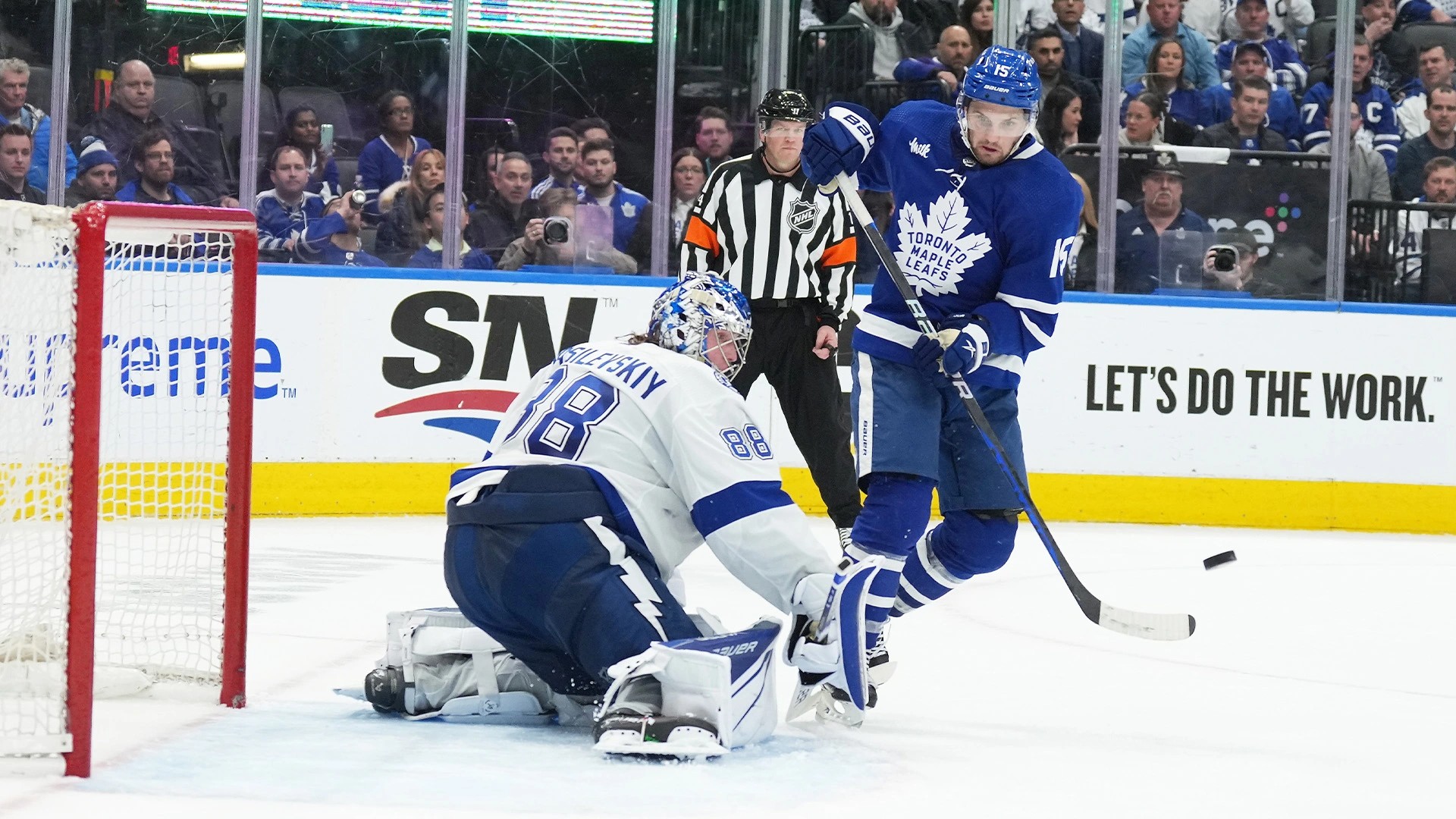
Coming into this series, special teams was one of the biggest storylines to follow. The opposing power play’s success and the failure of the Leafs’ man advantage was one of the most familiar narratives that Toronto fans had become accustomed to.
Facing a Tampa Bay PP that has singlehandedly won them playoff series in the past, it was obvious that the Leafs were going to need to be strong on special teams. They didn’t have to run up the score on special teams; they just had to prevent Tampa from doing so. Now that the series is over, we can say mission accomplished: the Lightning were 5/21 on the PP, and the Maple Leafs were 6/21.
Perhaps most interesting was how Tampa got their PP tallies. The Lightning scored four times on the PP in Game 1, two of which on the five-minute major penalty by Michael Bunting, but they then scored just once the remainder of the series. This contrasts last year, where the Lightning exploded in Game 2, but then notched a single PPG in Games 3, 4, 5, and 6. Giving up one PPG against is not a winning formula and the Leafs managed to correct it this season. They didn’t always look perfect on the PK and did need help from the post in Game 6 against the Stamkos one-timer, but the results are the results.
TJ Brodie was a hero on the PK, playing nearly 17 minutes in totality across the series, 2.5 more than any other Maple Leaf. Justin Holl was brutal at 5v5 in this series and was rightfully yanked, but his one contribution was a terrific muzzling of the Stamkos blast from the circle with multiple huge shot blocks.
David Kämpf, Mitch Marner, Noel Acciari, Mark Giordano, and Jake McCabe all chipped in as big supporting cast members to help post a good enough result shorthanded to get through the series. Where the 2019 Leafs crumbled against Boston by melting down on the PK over and over again, the 2023 Leafs finished the series off by holding their own shorthanded.
As for the Leafs’ PP, they were not perfect, but everyone would’ve taken a 28.6% clip before the series started. The PP was a major factor in Game 2’s victory. It tallied the game-turning third goal in Game 4 that kickstarted the comeback, and although it doesn’t count for the percentages, Game 3’s late tying goal by Ryan O’Reilly was at 6v5, which is also a man-advantage situation and is fundamentally the same as a PP.
Tampa made excellent adjustments to pressure the entry and drop-pass at center ice beginning in Game 4, which hampered the Leafs’ PP late in the series so we can’t say it’s all perfect now, but let’s compare it to playoff power plays past:
- 2022: 14.3 percent
- 2021: 13 percent
- 2020: 15.4 percent
All three numbers under Sheldon Keefe previously were ugly and represented key reasons for the team’s early exit. Not this year. The Maple Leafs won the special teams battle and it helped them win the series.
Six Final Thoughts and Notes From Round 1
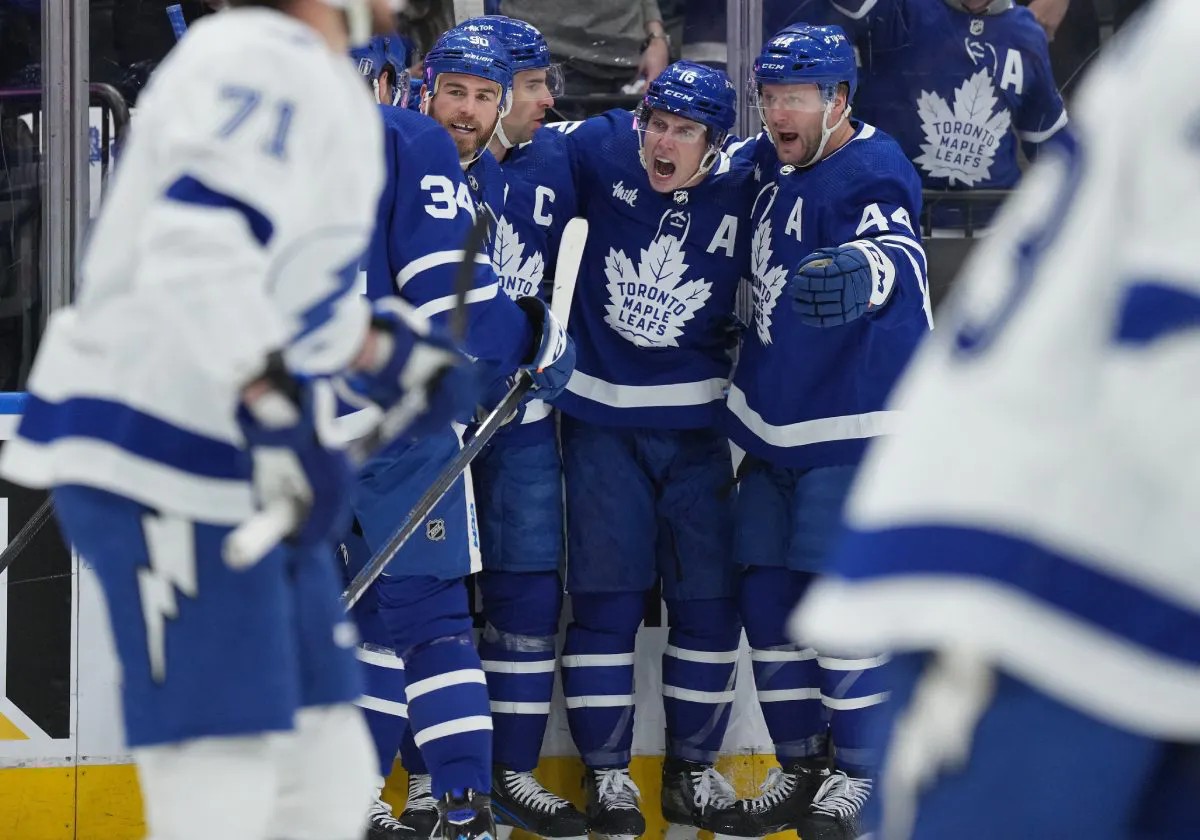
1. One of the biggest indicators that this time was going to be different is the Leafs got the opening goal in both clinching game opportunities. As I noted after Game 4, a big part of the Leafs’ struggles to close out series was perpetually conceding the first goal.
Entering this playoff series, the Leafs had gone seven straight potential elimination games where they did not score first dating back to Morgan Rielly‘s opening tally against Boston in Game 6 of 2019. Then Rielly scored to open Game 5 of this series. The Leafs didn’t hold that lead, but then they scored first again in Game 6 with the goal by Auston Matthews. Yes, they still struggle to hold extended leads in elimination games, but scoring first is the biggest step. They were finally rewarded for it.
2. There’s been much debate about the concept of “playoff goals” and whether they are different than regular season goals. I don’t think they’re radically different, but we do empirically know some things about the playoffs — fewer rush chances, less freedom to carve up an opponent and walk straight into the slot. Hockey analytics guru Prashanth Iyer tweeted out a good data visualization of where on the ice goals are scored more often (purple for the playoffs and teal for the regular season):
The playoffs are all about those greasy, netfront goals. A comparison of where goals are scored from in the regular season (teal) vs. in the playoffs (purple)
viz inspired by @thomas_mock's blog here: https://t.co/48YmBjqVFt pic.twitter.com/LQn8bDi11Q
— Prashanth Iyer (@iyer_prashanth) April 24, 2023
As you can see, fewer goals in the playoffs from the high slot and the circles, because teams so furiously protect the house. But on the flip side, there are more goals going in from the areas where you’d expect rebounds and deflections.
The reason I bring this up is that we’ve often lamented the Leafs’ willingness to play on the perimeter in the playoffs, contributing to their failures to score goals in Game 7s. This year, they showed much more willingness to throw pucks on net, using the oft-discussed screens/deflections to beat Vasilevskiy on shots that originated from far out.
Tavares’ series-winner was merely a puck thrown on net that got a lucky bounce, while Ryan O’Reilly‘s game-tying goal in Game 3 was a rebound off a shot by Nylander. Those are the sorts of goals the Leafs needed to figure out how to score. Hopefully, it’s a lesson they’ll carry forward into the second round.
3. The lineup changes after Game 5 were not the main reason the team won Game 6, but they certainly made the squad better. Erik Gustafsson was on-ice for the lone Lightning goal, but I thought he and Timothy Liljegren added something in puck-moving and offensive ability that they needed from the back end. I would keep Liljegren if the team goes back to 12/6, which I’m sure they will at some point in the near future.
If they return to 12/6, I would bring Zach Aston-Reese back in over Sam Lafferty. At forward, the addition of Michael Bunting paid off. Bunting looked rejuvenated and far more engaged than most of the games he’s played since referees began cracking down on him. He had some nice offensive plays in transition and nearly scored on a rebound off a shot by Mitch Marner, ringing the iron instead. Hopefully, the time out of the lineup served as an opportunity to reset Bunting’s game and has him ready to be an active contributor in round two.
4. A quick rundown of other heroes in the series starts with Luke Schenn. The stories write themselves on Schenn’s heroic return to Toronto, and he was legitimately terrific in the series — close to 18 minutes per game, on the ice for just one 5v5 goal against with expected goals and high-danger chances in his team’s favor. He also got some time on the PK and was half of the Leafs’ best pair next to Rielly.
I didn’t mention Ryan O’Reilly in the core players section, but he was a major offensive contributor (2-5-7 in six games) and logged nearly 20 minutes per night. ROR played a major role on the PK and the PP; while the Leafs didn’t win his minutes, he ate valuable time in the bottom six for them and only came out -2 in goals at 5v5.
You could say the same thing about his linemate Noel Acciari, who scored a pair of goals in Game 3 and 4 and who leads the Stanley Cup Playoffs in hits. Alex Kerfoot largely got caved in at 5v5 but did solidify his Leaf legacy by scoring the OT winner in Game 4.
Matthew Knies did not score a goal in the series but he was a major shot in the arm, helping extend plays and making the Leafs’ stars better. He notched three assists in five games, the Leafs fared just fine in his minutes, and he was on the ice for all three OT winners.
I thought TJ Brodie and Jake McCabe were very rough early on in the series but improved as the series went along. They deserve immense credit for helping to suppress the offense of the Lightning’s stars. Those two got very difficult minutes, which in turn helped free up Rielly-Schenn to flourish. They did enough. The Leafs were +1 with Brodie on the ice in goals at 5v5 and were only -1 in McCabe’s minutes — not to mention the role they both played on the PK.
The McCabe-Brodie pair has some things to iron out in their ability to get the puck out more cleanly, but in terms of stopping goals from going in, they did close to as well as you could ask for given the context.
5. You could also say the trade deadline was the difference in this series and you’d be correct in stating as much. The Leafs fortified their D corps by picking up McCabe and Schenn, while they got Acciari and O’Reilly to help prop up the offense (four combined goals). Kyle Dubas made their team better and all four of those players played key roles in this series.
Tampa Bay traded Vlad Namestnikov for Mikey Eyssimont, who did score a goal in the series, but I’m not sure you can say that deal moved the needle (Namestnikov probably could’ve scored a single goal, too). They also cashed in nearly all their remaining assets of value to get Tanner Jeannot, who missed three games through a combination of injury and ineffective play, which colored the three games he played in. No goals, no assists, no points, the Lightning were outscored while he was on ice, and only a fight against Schenn to note.
Could the Lightning have won this series if they’d used those five picks to get a different player at the deadline, one who played a much more productive part? There’s a case to be made. Dubas’ aggression in late February put the Leafs over the top.
6. My closing thought on this series is it seems quite fitting that this is the one that does it for the Leafs. Not a series they controlled or dominated, but one where the bounces they’d never gotten in this era finally went their way. The one where the sorts of games that never went well for this version of the Toronto Maple Leafs finally did. The one where they weren’t blowing leads but mounting furious comebacks. The one where they were outplayed in OT only to have a ho-hum seeing-eye shot meander its way into the net and end it.
Of course, it wouldn’t be against a pushover team they’re supposed to beat. It had to be against a vaunted opponent with a roster laced with Hall of Famers. Perhaps it would’ve been more poetic if it were in Game 7, but I don’t think any Leafs fans are complaining about that. Perhaps that demon will be vanquished in the coming weeks.





















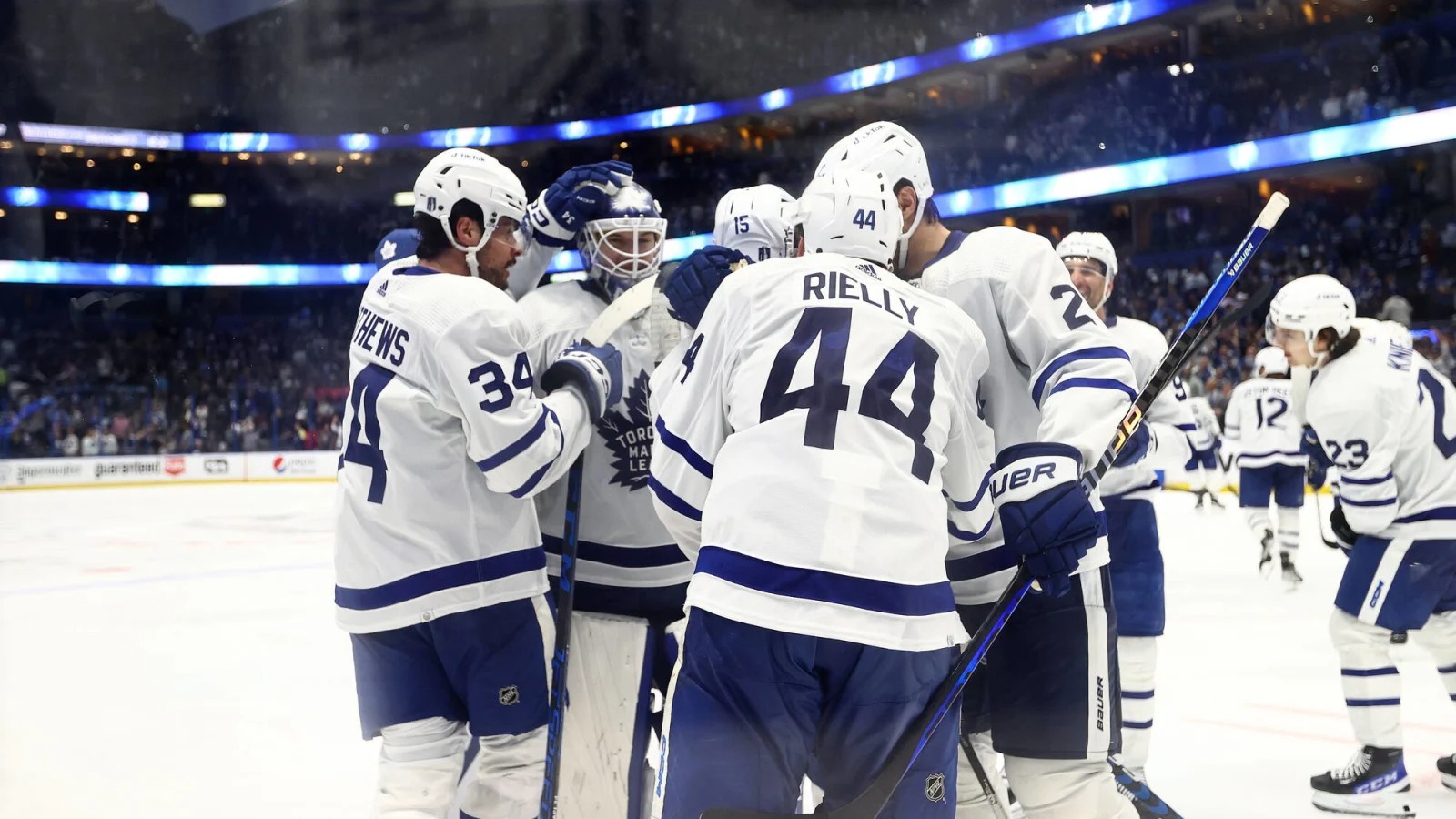








![New Leaf Anthony Stolarz on the opportunity in Toronto: “In Florida, I knew my role as a backup… Now, [Joseph Woll] and I are competing for starts… As a goalie, that’s all you can ask for” Anthony Stolarz, Stanley Cup win, now Maple Leaf](https://mapleleafshotstove.com/wp-content/uploads/2024/07/anthony-stolarz-sc-100x70.jpg)
